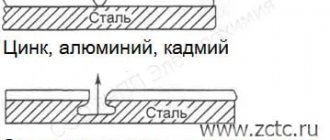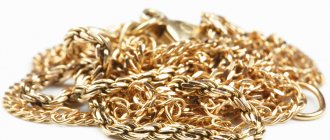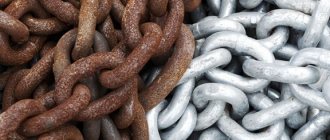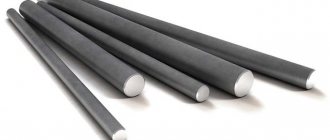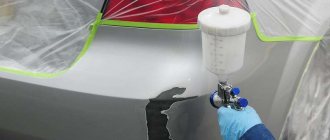- The difference between stainless steel and plain steel
- Factors causing corrosion
- Pitting corrosion
- Bimetallic/galvanic corrosion
- "Transplant" of simple iron
- Intercrystalline corrosion
- Crevice corrosion
- Erosive corrosion
By all accounts, stainless steel is a super alloy that will never rust.
But this assumption is not entirely correct, because under certain conditions even stainless steel is susceptible to corrosion. There are four main types of stainless steels: austenitic, ferritic, martensitic and duplex.
- Austenitic is dominant in the industry and accounts for more than 70% of total production. It contains a maximum of 0.15% carbon and a minimum of 16% chromium, which provides very reliable protection against rust.
- Ferritic has lower corrosion resistance compared to austenitic grades, but performs better than martensitic.
- Martensitic steel is formed during the quenching (rapid cooling) process of austenitic steel. It is characterized by the highest abrasion resistance and high strength. This type of steel is used in many non-invasive environments, including the production of surgical instruments.
- Duplex steels, which contain austenitic and ferritic phases, are highly resistant to local corrosion, especially pitting, crevice and stress corrosion cracking.
So why does stainless steel rust? Let's talk about this below.
Can stainless steel rust?
There are three groups of stainless steels, each of which has its own characteristics and specific application:
- Corrosion resistant steel. It has high resistance to corrosion in uncomplicated conditions - at home, at work.
- Heat-resistant steel. It is heat resistant, does not rust at elevated temperatures, and can be used in chemical plants.
- Heat-resistant steel. Remains mechanically strong at high temperatures.
Thus, not all types of stainless steel are intended for use in a particular aggressive environment. For example, using ordinary stainless steel in food production and frequent washing with chlorine-containing products will cause rapid deterioration of the material. Similarly, the use of metal in seawater will increase the corrosion rate significantly.
Also, rust often appears on stainless steel after welding (heat treatment), which was carried out without following certain rules. After mechanical damage to the metal, the consequences will be similar: pitting corrosion will occur at the site of the defect. Smooth, polished material usually rusts less intensely than rough material: on the latter, corrosion elements can appear much faster.
Protection against rust is violated where hot scale gets in, since a strong increase in temperature in non-heat-resistant steel causes alloying substances (mainly chromium) to burn out. After holes burn through, their edges and adjacent areas become susceptible to corrosion, although deeper layers of metal most often remain intact. Treatment with etching pastes and special emulsions will help save stainless steel.
Other causes of stainless steel corrosion:
- contact of the material with ordinary carbon steel (including through tools that used to cut ordinary steel),
- regular cleaning with metal brushes,
- ignoring mechanical or chemical treatment of the weld.
The cause of metal corrosion can also be its initially low quality. The resistance of steel to rust is due to the presence of chromium in sufficient quantities. This element, after exposure to water, air, acids and alkalis, forms a thin impenetrable layer that prevents the material from rusting. If there is little chromium in the composition or it is unevenly distributed, the creation and maintenance of an oxide layer becomes impossible.
What are the differences between the applications of cold-rolled sheets and hot-rolled sheets?
The difference in properties determines different areas of use.
Hot rolled sheet is most often used:
- in construction - for the manufacture of load-bearing coatings;
- in shipbuilding, aircraft and mechanical engineering;
- for creating structures using welded, bolted, riveted joints;
- for the production of welded pipes.
Application areas of cold rolled sheets:
- production of corrugated sheets, smooth galvanized sheets;
- automotive industry;
- obtaining tin - a thin sheet or strip with a protective, most often tin, coating, used for the manufacture of cans;
- etched annealed sheet - decapir - is used for the manufacture of enamel dishes.
Due to the high quality of the surface, cold-rolled sheets are well suited to powder coating, chrome plating, and nickel plating.
Source
Factors that determine metal resistance to corrosion
In order for the metal not to be subject to corrosion, it must undergo passivation - the transition of the surface to an inactive (passive) state, during which a thin protective layer is formed on it. Good stainless steel quickly and easily passivates under normal atmospheric conditions - contact with oxygen from the air. The more chromium in the steel, the higher its passivation ability and anti-corrosion properties.
In addition to chromium, steel is alloyed with nickel. It also contributes to passivation, but to a slightly lesser extent. Both metals provide the highest anti-corrosion resistance, although other elements can also be added to the steel: copper, niobium, molybdenum. To enhance the protective properties, any additives must be in a standard state, and when their structure changes, the resistance to corrosion decreases (for example, when chromium transforms into the form of nitride, carbide). This can happen during contact with strong acids: sulfuric, hydrochloric, hydrofluoric.
Passive layer
The passive layer is a thin oxide film that forms on steel after chromium reacts with oxygen. It only has a beneficial effect on the properties of stainless steel: on ordinary steel, oxygen, when interacting with iron atoms, provokes the formation of small pores and the appearance of rust. The corrosion layer will also be called passive, because it is reaction inert with respect to the environment.
Brief information
Cold rolled sheet (C/C) is a flat metal product that looks like long strips. C/C products are usually made of steel alloys, but sheets of other metals (aluminum, copper, duralumin alloys, brass) are also found. Cold sheets are produced in metallurgical shops by pressing hot-rolled sheets. C/C sheets are used for the production of car frames, cans and boxes, metal utensils, and corrugated sheets.
Cold steel is produced in large, long rolls, and to obtain an individual rectangle, the sheet metal is cut into individual pieces using industrial shears. Most cold-rolled strips have a small thickness - from 0.35 to 2 millimeters. Although there are also thick products, the thickness of which can reach up to 5 millimeters. The width of cold steel sheets usually ranges from 1.5 to 5 meters, although wider products are also available. C/C products, if necessary, can undergo additional processing - heating, tempering, galvanizing, mechanical deformation, applying a protective layer, painting.
Types of stainless steel corrosion
Based on the type of development, cause of appearance and symptoms, several types of stainless steel corrosion are distinguished.
Crevice corrosion of stainless steels
Crevice corrosion is a widespread type of rusting of stainless steel. It develops where there is a small gap in the structure, for example, when water penetrates under the fasteners into the product. The second surface is usually a rubber seal, a gasket, and sometimes a metal element.
The mechanism of formation of crevice corrosion is as follows:
- Accumulation of aggressive ions in the gap, displacing oxygen.
- The appearance of an anode in the gap (the material outside the gap plays the role of a cathode).
- The formation of corrosion due to changes in the acidity of the environment and electrochemical reactions.
To prevent crevice corrosion, structures must be designed correctly. It is important to provide cathodic protection, which will reduce acidity, as well as improve the fluidity of the medium.
General surface corrosion
General corrosion is the uniform destruction of the metal structure in part of the surface layer. It causes the destruction of the oxide film on most of the product or over its entire area. Usually the cause is contact with strong alkalis, acids, compounds of iodine, fluorine, bromine. The main “enemy” of stainless steel is considered to be chlorine, which is why chlorine-containing detergents should not be used to clean it.
Pitting
Stainless steels, as well as alloys based on aluminum and nickel, are most susceptible to pitting corrosion. Unlike ordinary steel, which more often suffers from general surface corrosion, such materials in most cases are covered with pitting - small defects. Local destruction of the passive layer occurs in the following situations:
- scratching, mechanical damage,
- local change in steel composition,
- point exposure to chlorine, sulfur, halide ions,
- temperature increase.
Spot rusting is considered the most common among different types of stainless steel. Because of it, holes appear in tanks and small cracks appear in pipes and tanks. Usually their diameter is no more than 1 mm, while the depth can be significant - this is the insidiousness of this phenomenon. As in the case of crevice corrosion, the specific pitting will act as the anode, and the remaining (undamaged) surface will become the cathode. Adding molybdenum to stainless steel during its production increases the product's resistance to pitting corrosion.
Intercrystalline corrosion
This process has another name - intergranular corrosion of stainless steels (ICC). It occurs when the temperature rises sharply, which happens, for example, during welding. Rusting begins if, with the participation of heating, chromium urea appears along the grain boundaries, that is, the structure of this alloying additive changes radically. For ferritic steel, the sufficient temperature for the formation of corrosion foci is +900 degrees, for austenitic steel – +450 degrees.
Contact corrosion
This type of corrosion develops when dissimilar metals come into direct contact with each other under the influence of electrolytes. For example, this happens when joining different metal products in an aggressive conductive environment - sea water. As a result, the steel locally deteriorates, and less noble metals may even dissolve.
Hot-rolled and cold-rolled steel sheets: differences and scope of application
One option for steelmaking is the production of cold-rolled sheets. They have medium or large length and width. But the thickness can be small - from 0.35 to 5 millimeters. Cold-rolled sheets are produced by cold rolling in metallurgical plants. It is used for the production of various small products and spare parts, as well as for the manufacture of external fences and hanging structures. What physical properties does the material have? How is cold rolled sheet produced? And how is it different from hot-rolled products? These issues will be discussed in the article.
Pitting Resistance Equivalent Numerical (PREN)
The RREN indicator is for reference; it shows the tendency of different types and brands of stainless steel to develop pitting. The numerical equivalent of pitting resistance is used as a guide, but not as an absolute guide, for determining corrosion resistance.
Typically, molybdenum, chromium and nitrogen are the most resistant to pitting rust as alloying additives. The higher the RREN number, the more resistant the steel will be to pitting. Here is some background information on RREN:
| steel grade | RREN |
| 444 | 25 |
| 430 | 16 |
| 304 | 19 |
| 316 | 26 |
| 304LN | 21 |
| 904L | 36 |
| 316LN | 27,5 |
| SAF 2507 | 42 |
| Zeron 100 | 41 |
Cold rolled sheets
- high accuracy and reduction of material losses due to the absence of excess;
- strength and corrosion resistance;
- fairly good weldability indicators, which allows the use of all types of welding, as well as high quality welds;
- the ability to use all anti-corrosion treatment technologies - galvanizing, powder painting;
- plasticity, thanks to which stamped parts are made.
- the main disadvantage is the limited sheet thickness of 5 mm;
- high cost compared to hot-rolled sheet.
Ways to protect stainless steel from MCC
Cleaning rust from a surface can sometimes be difficult, especially when the defect penetrates deeply. A number of methods have been developed against intergranular corrosion, here are the main ones:
- Annealing (stabilization). Ferritic steels are treated at high temperatures (+750...+900 degrees), due to which the concentration of chromium on the surface increases, and the distribution of the element becomes more uniform.
- Carbon reduction. If the concentration of the substance is less than 0.03%, then the metal will become practically not susceptible to intergranular corrosion.
- Quenching in water. This method is applicable to austenitic steel, it helps the chromium carbides to change into a more suitable form and concentrate on the grain boundaries of the metal.
To remove the tendency of stainless steel to undergo MCC, new additives are introduced into it: titanium, tantalum, niobium, but this leads to a serious increase in the cost of the material. Their quantity should be 5-10 times greater than the carbon norm, and then the metal will not be subject to rust.
Conditions in which rust occurs
There is no need for special conditions under which rust inclusions appear on the surface of stainless metal. A slight decrease in the concentration of chromium in the alloy is sufficient for the surface to become susceptible to destructive external influences. Another condition under which the outer layer begins to deteriorate is contact of iron with a stainless surface.
The condition under which a violation of the chromium-protected metal layer occurs is incorrect welding technology. Iron particles fall on the surface of the stainless steel. If you then poorly clean the surface, then the smallest particles lead to the appearance of corrosion inclusions on the stainless steel. A poorly cleaned weld seam, or rather the area around the welding site is covered not only with iron residues, but also with slag, welding spatter, and flux. The inclusions will not always develop into full-fledged corrosion with through holes. Even the most perfect seam will look untidy if the surface around it is not cleaned and defects are not removed. In the catalog on our website you can buy a stainless steel seamless pipe 12x18n10t - a way to avoid the risks that arise during welding.
Corrosion and surface treatment of stainless steel
Corrosion can be removed chemically - using special rust converters. Also, the surface of stainless steel products can be processed by milling, stripping, grinding, and polishing. The choice of a specific technique depends on the preferences of the specialist and a number of other conditions.
The selection of a method for preventive treatment of metal will be determined by the initial corrosion resistance of a particular steel grade. Elements of pitting corrosion are more likely to form on rough surfaces, while rust spots rarely appear on smooth surfaces. Grades 304, 316 rust quickly when used in seawater conditions, they need to be protected more carefully.
The difference between the properties of hot-rolled sheet and the characteristics of cold-rolled sheet
As a result of using different technologies, sheets are obtained whose properties differ significantly. The choice of cold-rolled or hot-rolled sheet depends on the functional purpose.
Advantages of Hot Forming
- The ability to produce products in a wide range of thicknesses – 0.4 (actually 1.2)-200 mm.
- Relatively low cost of the process.
- Higher corrosion resistance compared to the result of cold deformation.
Disadvantages of hot rolling:
- impossibility of obtaining high-quality thin sheets;
- the surface is uneven, with a depression in the center, low quality, likely the presence of scale;
- low dimensional accuracy;
- When welding, the sheet may “lead.”
Advantages of cold rolled sheet:
- the ability to produce flat products several microns thick;
- high geometry accuracy;
- smooth, high-quality surface, the product can be used for the manufacture of products in which the aesthetic component is important;
- does not “lead” when welding.
Disadvantages of this product
- low corrosion resistance in air without anti-corrosion surface treatment;
- often - reduced plasticity;
- high manufacturing costs due to the use of a wide range of sophisticated equipment and the high energy intensity of the process.
Features of the material
- High strength. Cold-rolled sheet metal undergoes a number of technological treatments that eliminate internal tension in the alloy and improve the strength of the material.
- Small thickness. The C/C product is produced by repeated pressing, which makes it possible to obtain a product of small thickness (less than 1 millimeter).
- Nice view. The surface of cold rolled products is clean (no scale, burning, or traces of thermal effects). Therefore, the material can be used for aesthetic finishing of surfaces or products.
- Low risk of rust formation. At the end of processing of C/C products, the material is usually heated for recrystallization, which minimizes the risk of corrosion during long-term use.
Please note that in addition to cold-rolled sheets, there are also hot-rolled sheets. These materials have much in common, and C/C products are produced from hot-rolled sheets using pressing.
The main differences between cold-rolled and hot-rolled steel
| Category | Cold rolled steel | Hot rolled steel |
| Production method | Rolling hot-rolled steel using industrial presses without heating | Heating steel blanks and then rolling them using a press |
| Strength | Very high | Medium or high |
| View | Nice look, has a metallic shine | Mediocre look, lack of shine |
| Complexity of production | High | Low or medium |
| Sheet thickness | From 0.35 to 5 millimeters | From 2 to 50 millimeters |
| Areas of application | Car frames, corrugated sheets, tableware, structural elements, finishing structures, pipe production | Flights of stairs, elements of suspended structures, production of underground pipes, construction |
Production technology
From a technological point of view, the production of C/C steel is a labor-intensive process that requires additional equipment, electricity, and skilled workers. Typically, cold-rolled steel is made in special workshops at metallurgical plants, and home production of such materials is almost impossible. For convenience, the production of C/C materials can be divided into three stages - pre-processing, rolling and pressing, and final processing. Below we will look at the steps in more detail.
Initial processing
For the production of cold-rolled steel, hot-rolled sheets are used, the thickness of which ranges from 2 to 10 millimeters. After smelting and processing, hot rolled products undergo a natural cooling stage, and then they are packaged into rolls and supplied to the cold rolling workshop. In the workshop, the material is unpacked and placed on a conveyor table. At the initial stage of processing, hot rolled products are cleaned, as well as the oxide film-scale is removed. This stage is very important, since in the case of rolling a material with scale, the oxide film will be pressed into the material, which will seriously reduce its physical properties, and can also damage the press rolls.
Descaling is carried out using two methods:
- Mechanical cleaning. In this case, scale cleaning is carried out using a stream of metal particles that are sprayed over the entire surface of the sheet under high pressure. For processing large sheets, processing is done using hand tools (the worker puts on a suit, picks up the tool and performs the stripping). In the case of compact products, rolled products can be placed in special chambers, where processing will be carried out automatically.
- Chemical cleaning. In this case, processing is performed using strong acids (hydrochloric, sulfuric, nitric, phosphoric). The processing is carried out in large pickling baths with acids, where rolled steel is placed for a short time. After etching, the metal surface is cleaned of acid residues, and then the rolled sheet is wiped dry and dried.
In practice, both methods are used in combination - first, the material undergoes chemical cleaning, and then shot blasting is performed. Combining these methods allows you to completely remove the protective film from the surface of the metal sheet. Also, the combined technique is less expensive in terms of technology, which helps reduce the cost of manufacturing the product. After cleaning the scale, the metal is unwound from rolls using automatic equipment.
Running in, pressing
After descaling, the coils are fed to a continuous rolling mill for hot-rolled strips. A metallurgical mill is usually equipped with five or four press stands that roll and press the material. The line must also be equipped with auxiliary equipment in addition to presses - unwinding rollers, metal shears, an automatic welding machine and others. Pressing and rolling is performed as follows:
- The metal roll falls onto an unwinder, which unwinds and feeds the strips onto the line. Immediately behind the unwinder there is a cage and shears, which, if necessary, crimp and cut the material (mechanically or hydraulically).
- After the strip passes through the first stand, the material enters the second and subsequent stands, where it is also crimped and cut. At the end, the product ends up on a drum, which winds the strip into rolls. Please note that at the initial stage, running-in occurs at low speed.
- After the end of the roll passes through all the stands, the compressed rolled products are packed into a roll. After several turns, the processing speed increases to 1-3 meters per second. This allows for quick break-in. When the roll comes to an end, the processing speed decreases again.
How to determine the mass of rolled products?
In plants or factories, industrial electronic scales are used to determine the weight of cold-rolled strip. The weighing procedure is carried out in a standard way - a strip is placed on the scales, and after a few seconds the weight of the object in kilograms or tons is displayed on the display. There are also indirect methods for determining the weights of sheet metal. The most popular of them is the use of a calculation formula that looks like this: W = P x L x W x H. The formula is deciphered as follows:
- P is the density of the steel product. The density value directly depends on the composition of the metal alloy. Depending on the amount of alloying additives, the density of steel ranges from 7700 to 7900 kg per cubic meter. For convenience of calculations, we will take the average density value - 7800 kilograms per cubic meter (calculation error - less than 3%).
- L (Length) — length of the product. Please note that the length must be taken in meters. If you have a length in centimeters, then this value must be divided by 100.
- W (Width) - the width of the product, expressed in meters. If you have a width value expressed in centimeters, then this value must also be divided by 100.
- H (Height) - sheet height, converted to meters. Height is often indicated in centimeters or millimeters. To convert this value to meters, you need to divide by 100 (centimeters) or 1000 (millimeters).
To understand this formula, let's look at an example. Let us have cold rolling; its length is 500 centimeters, width 100 centimeters, height 25 millimeters. It is necessary to determine its mass, taking the value of 7800 kilograms per cubic meter as the density parameter. To solve the problem, you first need to convert the length/width/height into meters - this will be 5 meters, 1 meter and 0.025 meters, respectively. Now let’s substitute the values into the formula: W = P x L x W x H = 7800 x 5 x 1 x 0.025 = 975 kilograms. Don't forget - this formula is suitable for determining the mass of rectangular sheets. If you have a cold-rolled sheet that has a non-standard shape or strongly rounded edges, then this formula cannot be used.
Properties of hot rolled steel
Hot rolled sheets have a rough surface. The finished sheet has rounded, imprecise corners. If they are trimmed, the material is marked with the index O; if it is supplied without trimming, it receives the index HO. The thickness of this type of steel is uneven and is characterized by a high percentage of scale content.
Assortment of hot-smoked sheets according to GOST
Accepted standards divide hot-rolled sheet metal into types according to thickness and area of use. Currently there are GOST standards with numbers:
- 14637-89, which describes the parameters of hot-rolled thick sheets with a thickness of 4-160 mm of normal quality, produced from carbon steels;
- 16523-97, which determines the properties of thin hot-rolled steel up to 3.9 mm;
- 5520-79, which normalizes the production of hot-rolled plate products with a thickness of 4-160 mm, the basis of which is carbon, low-alloy, alloy steel, used for the manufacture of boiler equipment and industrial vessels;
- 5521-93, describing sheets of normal and increased strength with a thickness of 4-60 mm, produced from steel with an increased proportion of manganese for use in shipbuilding;
- 6713-91, which specifies the parameters of rolled plates of low-alloy grades for the construction of bridges (conventional and northern);
- R 55374-2012, responsible for bridge structures made of alloy steels.
Hot rolled sheet dimensions
Hot rolled steel is cut into sheets according to dimensions regulated by GOST 19903-2015. This standard specifies a thickness of 0.4-160 mm. It takes ordinary unalloyed or low-alloy steel as a basis. If the metal is wrapped in rolls, its thickness should be 1.2-12 mm.
The edge may or may not be trimmed. Accuracy is described as improved or normal for thicknesses up to 12 mm. Flatness options: normal, improved, high, extra high.
Rolls are formed from a single piece of fabric or two welded pieces. Acceptable fragment lengths are no less than 1:5. Other parameters for the lengths and number of pieces are discussed with the customer.
Sheet width - 0.5-3.8 m, length - 7.1-12 m.
Advantages and disadvantages
Advantages of the hot rolled method:
| Disadvantages of the hot rolled method:
|




